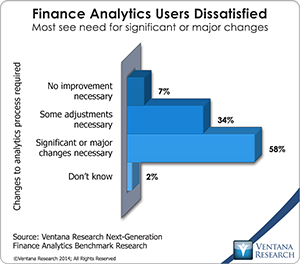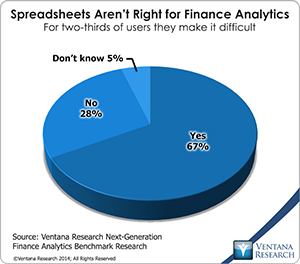Business computing has undergone a quiet revolution over the past two decades. As a result of having added, one-by-one, applications that automate all sorts of business processes, organizations now collect data from a wider and deeper array of sources than ever before. Advances in the tools for analyzing and reporting the data from such systems have made it possible to assess financial performance, process quality, operational status, risk and even governance and compliance in every aspect of a business. Against this background, however, our recently released benchmark research finds that finance organizations are slow to make use of the broader range of data and apply advanced analytics to it.
Analytics has long been a tool used by Finance. Yet because analytical techniques for assessing balance sheets, income statements and cash-flow statements are well developed and widely accepted,  finance professionals have had little incentive to do more even as the opportunities available to them have proliferated. Taking a narrow of finance analytics they have largely failed to take advantage of advanced analytics to address the full needs of today’s enterprise and thus to increase their own value to it.
finance professionals have had little incentive to do more even as the opportunities available to them have proliferated. Taking a narrow of finance analytics they have largely failed to take advantage of advanced analytics to address the full needs of today’s enterprise and thus to increase their own value to it.
It’s not that finance departments aren’t aware of their shortcomings. For instance, more than half (58%) of participants in this research said that significant or major changes to their process for creating finance analytics are necessary; only 7 percent said no improvements are needed. We found four main reasons for dissatisfaction with their process: it’s too slow; it isn’t adaptable to change; there aren’t enough skilled people to do this work; and data used in it is inaccessible or too difficult to integrate.
Usually, addressing some business issue requires dealing with a combination of the underlying people, processes, information and technology. Companies often fail to address the issue successfully because they focus on just one of these elements. We think it’s important to use the people, process, information and technology framework to isolate the root causes behind the issues. Let’s look at the role of technology – mainly software – in finance analytics.
Our research finds many companies have trouble with the technology aspects. Only 12 percent of organizations are satisfied with  the software they use to create and apply analytics; more than twice as many (27%) are not satisfied. That’s probably because 71 percent of them use spreadsheets for analytics, a higher percentage than for any other tool. Two-thirds of these users said that reliance on spreadsheets makes it difficult to produce accurate and timely analytics. In contrast, fewer than half use innovative techniques such as predictive analytics (44%) to assist planning and forecasting, and just 20 percent are employing big data to process the flood of data into today’s businesses.
the software they use to create and apply analytics; more than twice as many (27%) are not satisfied. That’s probably because 71 percent of them use spreadsheets for analytics, a higher percentage than for any other tool. Two-thirds of these users said that reliance on spreadsheets makes it difficult to produce accurate and timely analytics. In contrast, fewer than half use innovative techniques such as predictive analytics (44%) to assist planning and forecasting, and just 20 percent are employing big data to process the flood of data into today’s businesses.
The research demonstrates a correlation between the technology a company uses and how well its finance analytics processes work. Two-thirds of participants who said their software works well or very well also said their finance analytics process needs little or no improvement. By comparison, just one in four of those that said significant changes must be made to the software they use have a process that needs little or no improvement.
Here again we find that the inappropriate use of spreadsheets is an issue. When asked whether spreadsheets cause problems in their use of analytics, 67 percent said yes. This is because desktop spreadsheets have inherent shortcomings that make them poorly suited for any sort of advanced analytics. In particular, they cannot readily manage analyses involving more than a handful of dimensions. (A dimension is some aspect of business data such as time, business divisions, product families, sales territories and currency.) Many of these dimensions are constructed in hierarchies: Branches roll up into territories which roll up into divisions of companies, for example. Analyzing data usually requires viewing the data from different perspectives (which translates into dimensions) to isolate an issue or opportunity. One such would be looking at sales by product family and region and then drilling down into specific branches or stock-keeping units (SKUs). In doing analysis, it’s difficult enough to manage the dimensions of the purely financial aspects of a business. Spreadsheets are especially ill-suited to analyzing operational and financial data together, such as the delivery method or product configuration details.
Our research data shows that not having the right technology is impedes finance departments’ ability to create and use more advanced analytics. We found several reasons why companies decide not to make these technology investments. The top three are a lack of resources, no budget and a business case that’s not strong enough. The first two may be valid reasons, but not wanting to commit resources and budget to advanced analytics could be a symptom of a poorly constructed business case, as I noted earlier. A lack of leadership and vision on the part of senior finance executives also plays a role. Many may say they want their department to play a more strategic role in running their company yet fail to follow through to adopt new methods and the necessary supporting technology.
But now a new generation of finance department leaders is emerging. These are people young enough to have grown up with technology and to be more demanding in their use of software and systems to produce results. The time is ripe for change, and it’s up them to drive finance departments to be more strategic in their use of analytics.
Regards,
Robert Kugel – SVP Research












